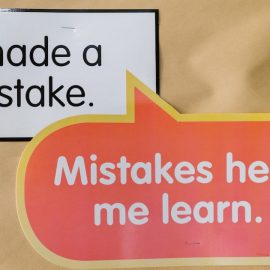

This article gives you a glimpse of what you can learn with Shortform. Shortform has the world’s best guides to 1000+ nonfiction books, plus other resources to help you accelerate your learning.
Want to learn faster and get smarter? Sign up for a free trial here .
Why do you need goals for your organization? What are the best tips and strategies for setting and achieving organizational goals?
Every organization wants to succeed, and organizational goals define what success means for you. Many business books cover how to set goals and objectives and this comprehensive guide brings together all of the best advice from these books.
Keep reading for our complete guide to organizational goals.
What Are Organizational Goals?
Goals establish where you hope to go and what things will look like once you get there. You’re establishing a measurable destination so you know what activities to prioritize and how to determine if you’re moving in the right direction. At the organizational level, goals do the same thing as they would for any individual. They specify what you want your company to accomplish and by when.
Goals Are Not Processes
While some goals are more challenging to define than others, they’re still definable. This may mean that you need to put more thought and effort into creating a clear goal for less tangible performance standards. First, Break All the Rules cautions against conflating goals with processes.
For example, employee satisfaction is an intangible skill. If you’re in upper management, you may be tempted to dictate the ways that lower managers are required to interact with their employees. However, this ignores their talents and forces them to adhere to a process they may not be comfortable with. Instead, you could develop an employee survey that teams fill out once a year that allows them to rank their satisfaction in their positions. These results give you an indication of your managers’ relationships with their employees and keeps you from forcing a potentially ineffective procedure.
The Importance of Goals
In The One Minute Manager, Ken Blanchard and Spencer Johnson discuss what goals are and why they are important. There are four key reasons you need to set organizational objectives.
Goals Define Success
They define what constitutes success and gives employees a target to drive toward. Many employees struggle because they don’t know what they’re supposed to be doing. This ambiguity around purpose is highly demotivating to employees. In this scenario, people get discouraged because there is no defined standard for success or failure, so any feedback they do receive seems arbitrary and capricious (especially if it’s negative).
With clearly defined goals, however, employees know exactly what to work on each day. They have an unambiguous idea of what success in their job means. Furthermore, they know how their work is contributing to the organization’s goals, which is motivating.
Goals Drive Accountability
It’s much harder for things to fall through the cracks,
because everything is clearly set down in writing and can be checked at any time through email. As a manager, you can better spot when there’s a gap between what’s supposed to be happening and what’s actually happening. Plus, your employees know exactly how they’re being measured and why they’re receiving the feedback you’re giving them.
Goals Motivate Your Team
Employees are happier and more productive when they have clear, stated objectives. This is because you’re able to give them meaningful and task-specific feedback on the work they’re doing. They’re learning and getting better at their jobs, because you’re aligning their day-to-day work with longer-term goals: they’re not working in a vacuum.
Think about what happens when you don’t give your team goals. Without goals, people have little basis on which to judge their own performance. They instead resort to self-evaluating based on whether or not they’ve been disciplined (which is typically the only type of feedback they receive under this style of management). If your employees believe that simply not being criticized by you is indicative of good performance (“No news is good news”), then you’re too disengaged and not providing enough structure for them to succeed. This will only hurt you and your organization in the long-run.
Goals Make Micromanagement Unnecessary
Clear organizational goals free you and your employees from the dreaded micromanagement cycle. Fundamentally, micromanagers don’t trust their employees: that’s why they feel the need to scrutinize everything their team does. This wastes everyone’s time, decreases morale, and hurts productivity because your employees never learn how to do anything on their own.
Goals establish that crucial foundation of trust right at the outset. You know your team is working on the right things, because you worked out the goals and performance standards with them directly.
Types of Goals
Before you figure out what organizational goals are right for you, it’s important to understand the different types of goals.
SMART Goals and Stretch Goals
In Smarter Faster Better, Charles Duhigg identifies two types of goals you can set:
- Type #1: SMART goals. These are smaller, more focused objectives. They are often the smaller steps you’ll need to take to fulfill your stretch goal.
- Type #2: stretch goals. These are ambitious and far-reaching goals that will often take a lot of planning and effort to accomplish.
SMART Goals
SMART goals are objectives that follow certain criteria. They must be:
- Specific: You must outline a targeted objective, not a vague aspiration.
- Measurable: You must be able to measure the goal’s success.
- Achievable and Realistic: You must actually have the time, resources, and capabilities to complete this goal; doing so has to be possible.
- Timely: You must have an expected timeline for accomplishing the goal.
These goals often have a much smaller scope than stretch goals. For the stretch goal of writing a book, a SMART goal might be writing one chapter, or even one section of a chapter.
There are various benefits to setting SMART goals. Because SMART goals are by design detailed and have been extensively thought through, the path to achieving them is often very clear. This can have a motivating effect. It’s easier to motivate yourself to work towards a goal when you have a clear plan to follow.
Likewise, by forcing you to set a timeline for the completion of your goal, SMART goals can encourage discipline. You can no longer procrastinate on your task: you’ve got a deadline to meet.
Example: The Typist Experiment
In 1975, two psychologists conducted a study on how setting goals could boost productivity. For their experiment, they recruited 45 typists from a large corporation. These typists were already considered very productive; on average, their output was 95 typewritten lines per hour. Each typist was given the goal of increasing their output by a certain number of lines per hour.
The psychologists made sure that the typists’ goals were SMART. Each typist received a specific output level to aim for that was realistic and achievable based on their capabilities and situation. They were given a timeline of when they should achieve this increased output, and they were shown how to measure their hourly output so that they could measure their progress towards the goal.
Within a week of starting the experiment, the typists’ average output rate had increased to 103 lines per hour. After another week, the average rose again to 112 lines per hour. When the researchers checked on the typists in three months, they were all still typing at their new faster rate. In fact, some were typing even faster than before. Having a SMART goal had boosted the typists’ productivity to unprecedented levels.
Stretch Goals
A stretch goal is an aim so audacious that at first glance, it might not seem possible. Examples of stretch goals include running a marathon, starting a successful company, or writing a book.
Setting and pursuing such ambitious goals can transform your perspective and your way of working in three ways:
- These goals are inspirational. They challenge you to be more productive so that you can achieve things you’d never dreamed could be possible.
- The challenging nature of stretch goals prevents complacency. You know that to fulfill such an ambitious goal, you’ll need to work hard and push yourself.
- In your quest to make the seemingly impossible possible, you become more imaginative, innovative, and willing to pursue new avenues of thinking.
Example: The Japanese Bullet Train
In the 1950s, the 320-mile train journey between the Japanese cities of Tokyo and Osaka could take up to 20 hours. This long journey time was problematic; this was a high-demand route, in terms of transporting both people and raw materials. So, in 1955, Japan’s top engineers were challenged to invent a faster train.
Within six months, the engineers had created a prototype of a train that could go 65 miles per hour. This was an impressive feat: they’d created one of the fastest trains of its kind in the world. However, when the engineers presented their design to the head of the railway system, he wanted something faster. He set them a new, audacious stretch goal: building a train capable of traveling at 120 miles per hour.
The engineers protested that this task was impossible. They named all sorts of issues that would prevent them from meeting the goal. For example, trains traveling that fast would derail if they turned corners too sharply. To get rid of the need for trains to turn, they would need to tunnel through mountains, which would be an incredibly expensive process. It just didn’t seem feasible. However, the head of Japan’s railways was insistent: they were going to do whatever it took to meet their stretch goal.
The engineers realized that the only way to meet their seemingly impossible stretch goal was to completely transform every element of the Japanese railway system. Over years, they innovated everything from new train cars to stronger tracks. They even drilled tunnels through the mountains! With each innovation, the train’s maximum possible speed would increase.
Eventually, the engineers achieved their goal. The new bullet train traveled at an average speed of 120 miles per hour. This reduced the journey time between Tokyo and Osaka from 20 hours to just under four hours. The stretch goal gave the engineers the push they needed to challenge their perceived limitations, innovate, and produce the seemingly impossible.
Big Hairy Audacious Goals (BHAGs)
Similar to stretch goals are another type of goal from Built to Last by James Collins and Jerry Porras. Research revealed that far from being overly cautious, visionary companies in fact set risky, progress-stimulating goals—what Collins and Porras have coined Big Hairy Audacious Goals (or BHAGs, pronounced bee-hags). BHAGs are goals that take you out of your comfort zone and require a strong commitment to see them through. They typically take 10 to 30 years to achieve and only have a 50- to 70-percent probability of success, but you should be able to look at them and believe that you can achieve them.
If you’re an entrepreneur, then you’re no stranger to BHAGs, as getting a business off the ground is already a BHAG in itself. If you work for a company, you can pursue BHAGs at any level, whether it’s within your team or within the entire corporation.
- For example, if you’re a new hire in the accounting department of a big corporation, your BHAG might be to become the vice president of finance within 15 years.
Visionary companies use four different types of BHAGs:
- Ambition: This can be a quantitative or qualitative target that you want to reach. For example, a fledgling fast-food restaurant might have a BHAG of selling 100 million burgers within 10 years.
- Challenger: This focuses on beating the competition, a specific strong player in the industry. For example, a yoga wear company’s BHAG might be to unseat Lululemon as the most recognizable brand in the industry.
- Icon: This focuses on emulating a successful company, which may or may not be in the same industry. It’s particularly great for new businesses. For example, a new manufacturing company’s BHAG might be to become as globally recognizable as 3M.
- Refresher: This might be a shift in the product offerings or a revamp of a company’s image. It’s especially effective for old or big organizations. For example, a company known for cheap, low-quality cosmetics might set a BHAG to become a respected player in the skincare industry.
How to Set Organizational Goals
Every organization has different goals. For example, a retail store may focus primarily on customer satisfaction whereas a medical organization may focus primarily on patient safety. While these goals aren’t mutually exclusive, these organizations have different priorities because they have different purposes.
How to Define Your Team’s Goals
When defining your organization’s goals, think about the following three questions from First, Break All the Rules:
Question #1: What Do Your Customers Need?
This is the first question you need to ask because, without customers or clients, your company has no value. Use focus groups or customer surveys to ask your clientele what they want and expect from their experience with you. Use this information to inform your organization’s goals by zeroing in on the items that your customers feel passionate about.
For example, if you manage a grocery store, you may believe that promoting new products is the best way to bring in customers. However, if your customers just want to be able to consistently buy the products that they love, they won’t necessarily care how many new products you’re bringing in. In this situation, you need to adjust your goal away from bringing in different products and shift it towards maintaining stock of popular products.
Question #2: What Does Your Company Need?
While a company’s core mission typically remains the same over time, the strategies you use to execute that mission change. Adapt your goals as you change your strategies. This adjusts the focus of your desired outcomes toward your new approach to fulfilling your company’s mission.
For example, you manage a design team within a clothing company. Your company’s core mission is to create affordable and stylish clothing. At its conception, your company’s strategy was to focus on the creation of new designs to attract new customers. However, as your company has become more mainstream, they’ve decided to shift their strategy to creating clothing that can be mass produced at a low-cost to keep up with the demands of current customers. To accommodate this, you shift the goals of your team from “unique designs per month” to “cost per design.”
Question #3: What Do Your Employees Need?
As you now know, every employee has a unique set of talents that inform the way that they work. When you set goals, you need to keep these talents in mind to adapt to each employee. While this is more challenging with larger or more standardized teams, you need to adjust as much as possible to ensure a more effective result.
For example, you manage a development team that creates new gadgets for various industries. Overall, you’ve set a goal for your team that requires them to complete ten designs per quarter. However, you know that each individual member of your team is motivated by different striving talents (as a reminder, striving talents inform an employee’s motivations).
Kelsey has the striving talent of completion whereas Eric and Ben have the striving talent of competition. You give Kelsey the additional goal of testing at least two of her designs before the end of the quarter and attach it to a financial incentive. On the other hand, you put Eric and Ben on the same projects and agree to give a bonus to whomever comes up with better designs for each project.
The OKR System
Measure What Matters by John Doerr helps you figure out what matters at your company and how to measure its success. The first step to knowing what matters is clarifying your OKRs, objectives and key results.
Objectives
The objective is the goal: what the company, team, or individual aims to achieve.
Objectives:
- State the overall goal or vision
- Must be tangible, concrete, and objective
- Must be action-oriented
Example: Hire new employees to meet the needs of the expanding organization.
Key Results
Key results are benchmarks toward the objective.
Key results:
- State the measurable sub-goals that, if achieved, will collectively result in achieving the objective
- Usually include numbers (revenue, market share, active users, growth, and so on)
- Include specific deadlines
Example:
Objective: Hire new employees to meet the needs of the expanding organization.
- Key Result #1: Meet with 3 candidates this month for the role of director of finance and hire 1.
- Key Result #2: Meet with 5 candidates this quarter for the role of marketing manager and hire 1.
- Key Result #3: Meet with 5 candidates this quarter for the role of product manager and hire 1.
How to Implement the OKR System
Step 1: Identify your objectives. Start with the company’s biggest priorities. Ask yourself, “What are the most important tasks we need to accomplish in the next three months, the next six months, and the next year?”
Once you’ve identified your organization-level objectives, departments, teams, and individuals identify their own objectives. About half of an employee’s objectives trickle down from the top. The employee creates the other half herself.
Step 2: Identify your key results. For each objective, ask yourself, “What steps do I need to complete to reach my objective?”
Step 3: Decide on the length of your OKR cycle. Your team should operate on the same goal-setting schedule, or OKR cycle. For most companies, there are two simultaneous OKR cycles, quarterly and annual. Annual cycles are for long-term OKRs, and quarterly cycles are for short-term OKRs that support the longer-term objectives.
Step 4: Choose a cloud-based management system. To effectively track OKRs, you need a place to store and share them. A cloud-based system is best. (Shortform note: Cloud-based OKR systems include WorkBoard, Ally, Culture Amp, and Asana. You can also simply use shared documents.)
Step 5: Designate an “OKR shepherd.” For the OKR system to work, everyone, from the CEO to the lowest-level employee, has to take part. But you’ll likely encounter resistance and procrastination. It’s useful to put someone in charge of keeping the rest of the team or organization accountable for setting and working toward their OKRs.
Step 6: Set stretch goals. Eventually, in addition to “committed OKRs” (objectives that must be met for your company to function and thrive), you should create “stretch OKRs,” objectives that make you feel a little uncomfortable because you’re not sure you can accomplish them. Stretch OKRs push you to achieve more than you thought possible.
Step: 7: Check in with employees weekly or monthly, and continually reassess OKRs. If they’re no longer relevant, jointly decide to change or discard them, even mid-cycle.
Step 8: Score and reflect. At the end of each cycle, score your performance for each OKR. Reflect on how you did and what that means about the goals you set. What will you do differently next quarter?
Step 9: Repeat this cycle every month or quarter. Realize that hitting on an effective OKR system takes time, so be patient with yourself, your colleagues, and your administration.
Communicating Organizational Goals
Setting goals is only the beginning of the process. You need to communicate the goals throughout the company. Achieving organizational goals requires employees to be on board and willing to put in the effort required as well. It is your responsibility as a leader to ensure that alignment.
Align Organizational Objectives With Individual Goals
In The Leadership Challenge, James Kouzes and Barry Posner identified three methods for ensuring clear communication and alignment.
Strategy #1: Develop Common Goals
The first step to encouraging strong bonds is to enlist your team in a common purpose. Shared goals unite people in cooperative efforts, in which everyone feels that their success contributes to everyone else’s success, and that no one can be successful unless everyone works together.
Structure your team’s roles and responsibilities so that their individual objectives contribute to a larger objective, and make sure they see how the two are connected. This can also be effective in reconciling people who don’t particularly like each other: Assigning two people who don’t get along to work together can help them get past their distrust once they’re working toward a common purpose.
Strategy #2: Educate About Key Company Metrics
Make sure your team members understand the fundamentals of how your organization works, so they’re able to make critical decisions about key issues when needed. If your team members don’t understand how your organization works, they won’t have a sense of ownership and can’t step up into leadership roles. Educate them about important elements of your organization, including its:
- Most important customers, clients, suppliers, and stakeholders
- Goals and how you measure progress toward them
- Track record of performance
- Pipeline of products, services, or ideas
Strategy #3: Be Clear About Rules and Expected Outcomes
People can’t live up to your expectations if they aren’t clear on what those expectations are. Make sure your team members know what you’re looking for, and praise them when they deliver.
To set expectations, reiterate your goals. Goals give context to your recognition of others’ work and enhance the importance of that recognition, allowing others to see how their actions contribute to the larger picture.
When a team member doesn’t perform to your standards:
- Outline for them clearly and specifically what they need to do to improve.
- Assure them that you have confidence they can do it.
- Connect their effort to your overriding goal—for example, you might point out, “The more we do this, the better the outcomes for the patients.”
The OKR System and Organizational Transparency
Alignment of organizational goals and individual work is also a critical part of the OKR system in Measure What Matters. OKRs are good at aligning companies because OKRs are always public. CEOs can look at the goals of their executives, managers, and junior staff, and junior staff can (and should) look at the goals of their bosses and the CEO. This allows people to coordinate their goals with those of the company and their peers.
Execution Is the Key to Achieving Organizational Goals
Goals are just theoretical until you start achieving them. How do you give your company the best chance of success? These are the four best tips from Blue Ocean Strategy, Traction, Built to Last, Give and Take, and Measure What Matters.
Break Down Goals Into Achievable Blocks
A massive strategic vision can seem daunting—how in the world can it be accomplished within a short time frame? Break up the goal into small atomic blocks. It’s just one step at a time.
Most entrepreneurs have a vision for their company, which they assume everyone else can see as well as they can. But many times, others in the organization don’t see it. To get traction—the ability to execute, or make the company’s vision a reality—you need to clearly define and communicate your vision.
Your vision defines your organization, and it spells out where it’s going and how it’s going to get there. To create a vision and break it down into achievable blocks, determine the following:
- Your defining values: Your core values serve as guiding principles for your company. They define your culture and who you are. You build a culture around your core values by letting them guide you when you hire, fire, review, and reward people.
- Your focus: To determine your core focus, you need to know two things: your company’s purpose and its niche.
- Your 10-year target: Discuss with your leadership team where you want to take your company. Start by asking what the company’s revenue goal could be in 10 years. The right target is one that generates energy and excitement throughout the company.
- Your marketing strategy: One reason you need clarity about your core focus is so you can then focus your marketing strategy effectively. An effective marketing strategy has four parts: your target market, a prospect list, your differentiators, and your unique process for doing business.
- Your three-year goal: In writing your three-year goal, focus on measurables and bullet points, not details—that is, focus on the end point rather than the potential hurdles.
- Your one-year plan: A plan for what has to happen this year creates traction for achieving your vision.
- Your 90-day priorities: Your leadership team should set 90-day priorities to put you on track to meet the one-year goal, which positions you to meet your three-year and 10-year targets.
- Your issues: With your leadership team, discuss and list any issues you’re likely to encounter in pursuing your vision. Maintain and continually update your issues list as part of operating your business.
Be Fully Committed
It’s not enough to have a BHAG; you also need to be willing to do whatever it takes to achieve it.
Look beyond the money. Visionary companies are driven by something greater than profit. They are driven by a compelling urge to keep pushing the bounds of impossibility while remaining firmly grounded in their core ideology.
Your organizational goals should have commitment throughout all levels of the company in order to have the best chance of success. Make it institutional. A BHAG should be built into the organization and should be exciting enough to maintain momentum, transcending any disruptions such as a change in leadership.
Commitment is about more than just a specific goal. Keep setting more BHAGs. Visionary companies aren’t complacent; they know that the work isn’t done just because they’ve reached a goal. Instead, they have other BHAGs lined up and employ other ways to stimulate progress. Without another BHAG to pursue, they end up becoming stagnant.
Ensure You Have Givers on Your Team
Americans tend to see independence as strength, and interdependence as weakness. Takers tend to see themselves as superior to others and collaboration as opening vulnerabilities to being overtaken.
In contrast, givers focus on achieving the goals of the group and see collaboration as harnessing the best of multiple people. They take on tasks that are in the best interest of the group and not necessarily of themselves. This isn’t necessarily purely altruistic – givers understand that the best thing for themselves is for their group to perform as well as possible.
Evidence shows that the more giving group members are, the more successful they tend to be in group performance and individual raises. There are a few reasons for this.
When givers show they care more about the group, they signal that they care less about themselves and intra-competition. In turn, they earn their collaborators’ respect and trust, which opens bandwidth of collaboration. Takers no longer feel competitive with a giver, matchers feel they owe a giver, and givers identify with a giver.
Giving and taking are both contagious. Because many people are matchers and use tit-for-tat strategies, adding takers to the mix promotes competitive and zero-sum behaviors that can drag the whole group down. People are wary of sharing creative ideas for fear of being exploited – indeed, taking behavior tends to lower creativity.
But adding givers to the group can push the whole group to focus on the overall goals and increase collaboration. Much knowledge work relies on collaboration and working with a set of particular team members. It’s not as much a solo game where a superstar can join another team and magically make things work.
Track Your Progress on Organizational Goals and Objectives
You have to be accountable for the goals you set, and checking in periodically to monitor progress is essential.
Tracking in an OKR System
OKRs are always measurable, and at the end of each OKR cycle you score them. These scores help you track your progress, and they indicate when you need to double down on a particular goal or when you should revise or abandon it.
During the OKR cycle, check-in with your manager weekly or monthly to discuss your OKR progress and decide among four options for each goal:
- Option #1: Continue the objective or key result—If everything’s going well and you’re making progress, keep going.
- Option #2: Revise the objective or key result—If changes in your environment or workflow have caused the goal to get off track, update it.
- Option #3: Start a new objective or key result—As conditions change, you may need to add new goals. If you already have five objectives, put one or two on the backburner to make room for the new goal.
- Option #4: Stop an objective or key result—Some goals become irrelevant or impractical. Don’t stubbornly cling to a goal just because you set it. If it no longer serves your larger purpose or the company’s, toss it.
Performance Management Meetings
Performance management consists of meetings and conversations that help you to focus on the progress and performance of your employees. These sessions differ based on the needs of the employee, the company, and the position. However, good performance management routines all share the following four characteristics:
- Characteristic #1: The sessions are simple. These sessions shouldn’t use complicated terms or overblown surveys. They should contain simple questions that don’t require much deciphering.
- Characteristic #2: The sessions are frequent. Yearly meetings or reviews don’t allow you to effectively keep track of an employee’s progress. These sessions should be scheduled semi-annually at minimum. This allows you to discuss issues and accomplishments as they arise instead of in a generic fashion months after they occur.
- Characteristic #3: The sessions are focused on the future. While these sessions do require looking to the past and reviewing performance, they’re ultimately meant to help develop a plan for the future. Spend the first 10 minutes reviewing performance, then spend the rest of the session discussing future plans.
- Characteristic #4: The sessions are employee-centric. Have your employees track their own progress and discoveries. Have them write down where they’ve excelled, where they’ve struggled, and what they’ve learned. This forces employees to take responsibility for their own performance and promotes self-discovery
Conclusion
Everyone wants their company to succeed, but how do you get there? Define success with organizational goals, communicate those goals and empower employees to help meet them, and ensure you can achieve goals with key execution strategies.

Want to fast-track your learning? With Shortform, you’ll gain insights you won't find anywhere else .
Here's what you’ll get when you sign up for Shortform :
- Complicated ideas explained in simple and concise ways
- Smart analysis that connects what you’re reading to other key concepts
- Writing with zero fluff because we know how important your time is






